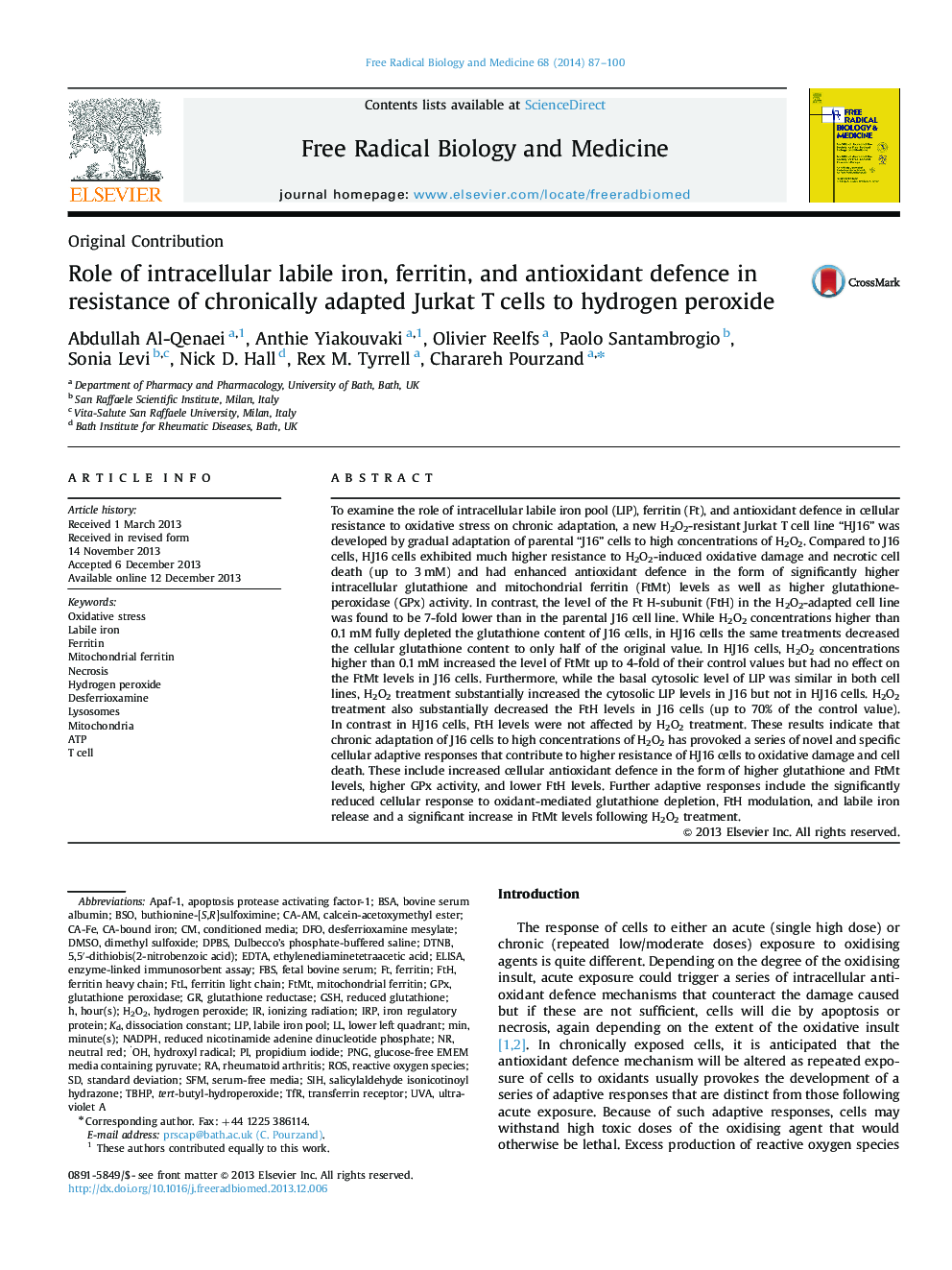| Article ID | Journal | Published Year | Pages | File Type |
|---|---|---|---|---|
| 8270723 | Free Radical Biology and Medicine | 2014 | 14 Pages |
Abstract
To examine the role of intracellular labile iron pool (LIP), ferritin (Ft), and antioxidant defence in cellular resistance to oxidative stress on chronic adaptation, a new H2O2-resistant Jurkat T cell line “HJ16” was developed by gradual adaptation of parental “J16” cells to high concentrations of H2O2. Compared to J16 cells, HJ16 cells exhibited much higher resistance to H2O2-induced oxidative damage and necrotic cell death (up to 3Â mM) and had enhanced antioxidant defence in the form of significantly higher intracellular glutathione and mitochondrial ferritin (FtMt) levels as well as higher glutathione-peroxidase (GPx) activity. In contrast, the level of the Ft H-subunit (FtH) in the H2O2-adapted cell line was found to be 7-fold lower than in the parental J16 cell line. While H2O2 concentrations higher than 0.1Â mM fully depleted the glutathione content of J16 cells, in HJ16 cells the same treatments decreased the cellular glutathione content to only half of the original value. In HJ16 cells, H2O2 concentrations higher than 0.1Â mM increased the level of FtMt up to 4-fold of their control values but had no effect on the FtMt levels in J16 cells. Furthermore, while the basal cytosolic level of LIP was similar in both cell lines, H2O2 treatment substantially increased the cytosolic LIP levels in J16 but not in HJ16 cells. H2O2 treatment also substantially decreased the FtH levels in J16 cells (up to 70% of the control value). In contrast in HJ16 cells, FtH levels were not affected by H2O2 treatment. These results indicate that chronic adaptation of J16 cells to high concentrations of H2O2 has provoked a series of novel and specific cellular adaptive responses that contribute to higher resistance of HJ16 cells to oxidative damage and cell death. These include increased cellular antioxidant defence in the form of higher glutathione and FtMt levels, higher GPx activity, and lower FtH levels. Further adaptive responses include the significantly reduced cellular response to oxidant-mediated glutathione depletion, FtH modulation, and labile iron release and a significant increase in FtMt levels following H2O2 treatment.
Keywords
DesferrioxamineUVANADPHDPBSGSHGPXLIPDTNBAPAf-1BSOIRPSfMSIHsalicylaldehyde isonicotinoyl hydrazonetBHPapoptosis protease activating factor-1FTHPNGFtMtFTL5,5'-dithiobis(2-nitrobenzoic acid)Desferrioxamine mesylateDFOFBSTFRBSADMSOROS·OHHydrogen peroxideATPRheumatoid arthritisbovine serum albuminLabile ironEDTAEthylenediaminetetraacetic acidLabile iron poolUltraviolet Astandard deviationionizing radiationtert-Butyl-hydroperoxideELISAEnzyme-linked immunosorbent assayOxidative stressDissociation constantMinNeutral redminute(s)Dimethyl sulfoxideHydroxyl radicalserum-free mediaconditioned mediaFerritin Heavy ChainFerritin Light Chainhour(s)fetal bovine serumT cellFerritinmitochondrial ferritindulbecco’s phosphate-buffered salineLysosomesMitochondriaNecrosisH2O2iron regulatory proteinPropidium iodidereduced nicotinamide adenine dinucleotide phosphatereduced glutathioneglutathione reductaseglutathione peroxidaseReactive oxygen speciestransferrin receptor
Related Topics
Life Sciences
Biochemistry, Genetics and Molecular Biology
Ageing
Authors
Abdullah Al-Qenaei, Anthie Yiakouvaki, Olivier Reelfs, Paolo Santambrogio, Sonia Levi, Nick D. Hall, Rex M. Tyrrell, Charareh Pourzand,
